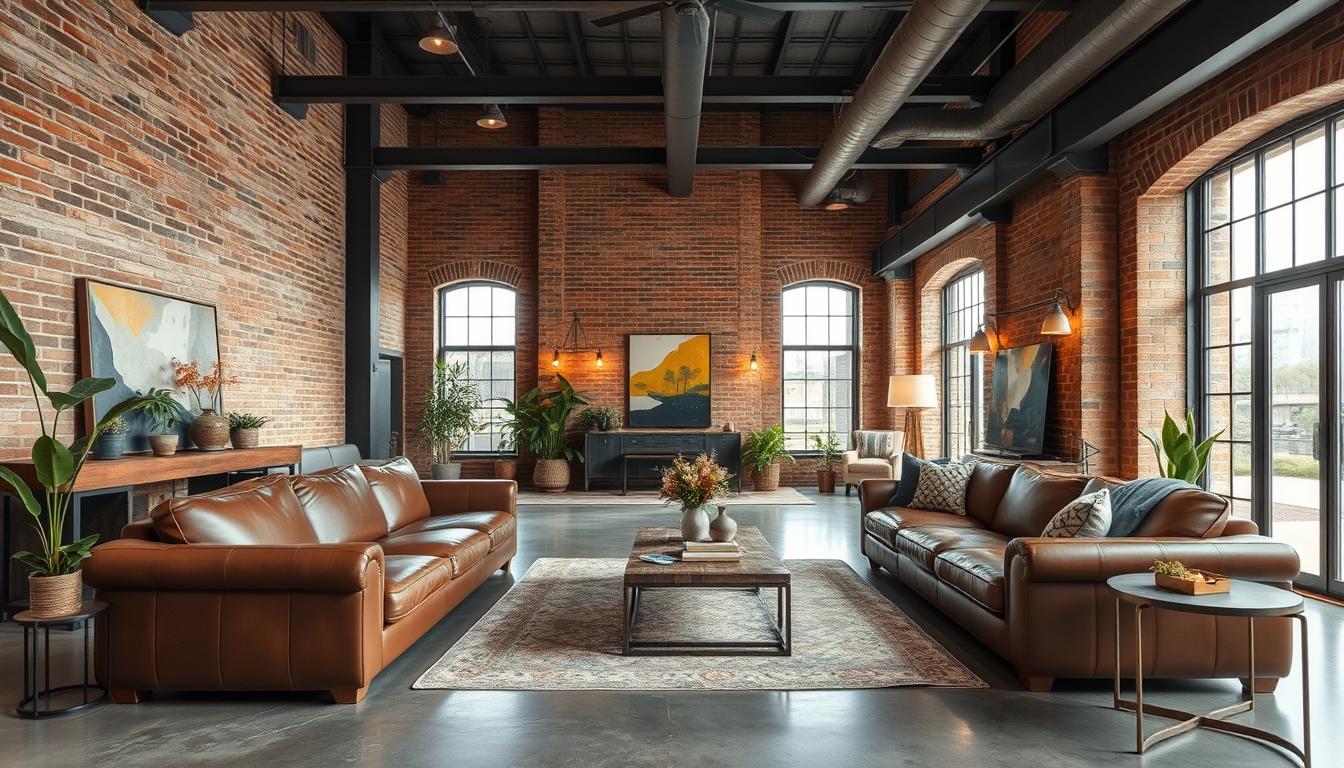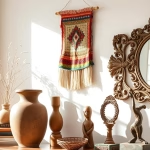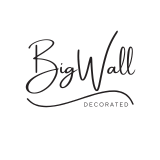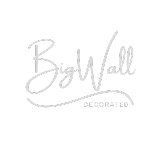Did you know about 70% of industrial interiors use raw materials like exposed brick and metal? This shows the heart of modern industrial design. It mixes old factory charm with modern urban living. It aims to inspire creativity and function, with high ceilings and lots of natural light.
This design is known for its rough textures and simple colors like black, gray, and brown. It’s inspired by old urban lofts and warehouses. It focuses on big, bright spaces. Key features include exposed structures, reclaimed wood, and metal.
Want to make your urban space look better? Learning about modern industrial design can help. It turns any area into a stylish and useful place. Let’s explore the key tips and guide to get the modern industrial look.
Key Takeaways
- Approximately 70% of industrial interiors incorporate raw materials like exposed brick, concrete, and metal.
- Modern industrial design features a blend of rustic and contemporary elements to create functional urban living spaces.
- Open floor plans and high ceilings are essential to achieve the industrial look.
- A neutral color palette forms the foundation, with blacks, grays, and browns being predominant.
- Incorporating reclaimed wood and metal accents adds texture and authenticity to the design.
- Abundant natural light from large windows enhances the overall aesthetic.
Introduction to Modern Industrial Interior Design
Modern industrial interior design mixes the raw look of old factories with today’s style. It started in the 1700s with the Industrial Revolution. In the 1960s and 1970s, old factories and warehouses became homes, making this style popular.
Evolution of Industrial Style
The industrial style began in the early 1900s, focusing on function and raw materials. Over time, it evolved with exposed brick, concrete floors, and metal accents. Designers like Del Piero and Vuong and Trang have updated it, adding polish and clean lines.
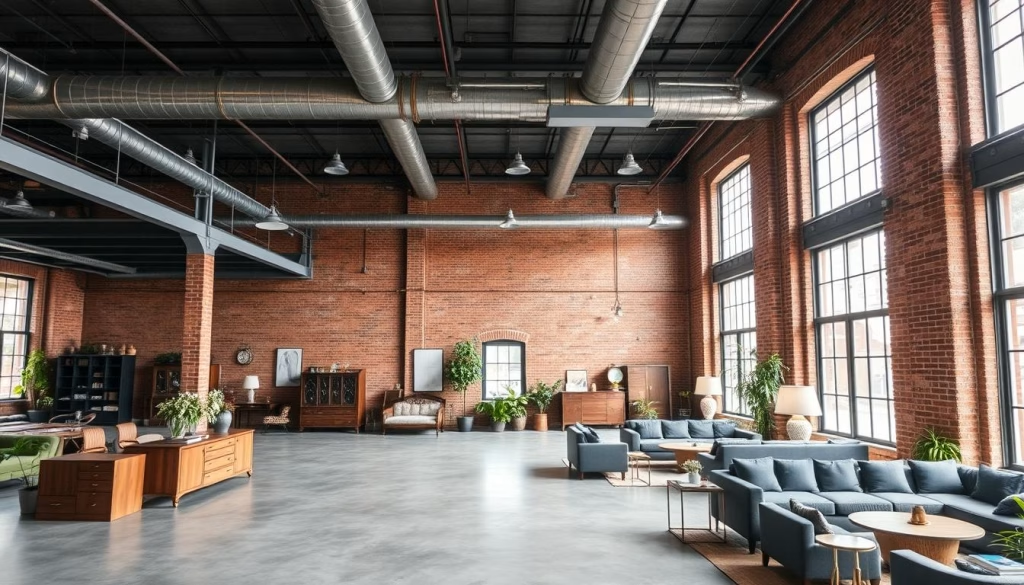
Key Characteristics of Modern Industrial Design
Modern industrial design uses raw materials like steel beams, concrete floors, and reclaimed wood. It also has big windows for lots of natural light. A neutral color scheme, including gray, black, white, and brown, is common.
It’s all about keeping things simple, letting the raw elements shine. Vintage and repurposed furniture add authenticity. Lighting, with metal or iron fixtures and exposed bulbs, makes the space warm and inviting.
The future of industrial design is going green and mixing styles. It’s becoming a top choice for homes and businesses wanting something unique and lasting.
| Key Characteristics | Description |
|---|---|
| Raw Materials | Use of steel, concrete, and reclaimed wood |
| Neutral Palette | Shades of gray, black, white, and brown |
| Vintage Furniture | Repurposed pieces to add character |
| Lighting | Metal fixtures with exposed bulbs |
| Open Floor Plans | Promoting interaction and fluid movement |
Neutral Color Palette for Urban Living Spaces
The industrial interior design style often uses a neutral color palette. Shades of gray, black, and white are common. This simplicity and authenticity are key to the style. Adding earthy tones can warm up these spaces, keeping them grounded and minimalist.
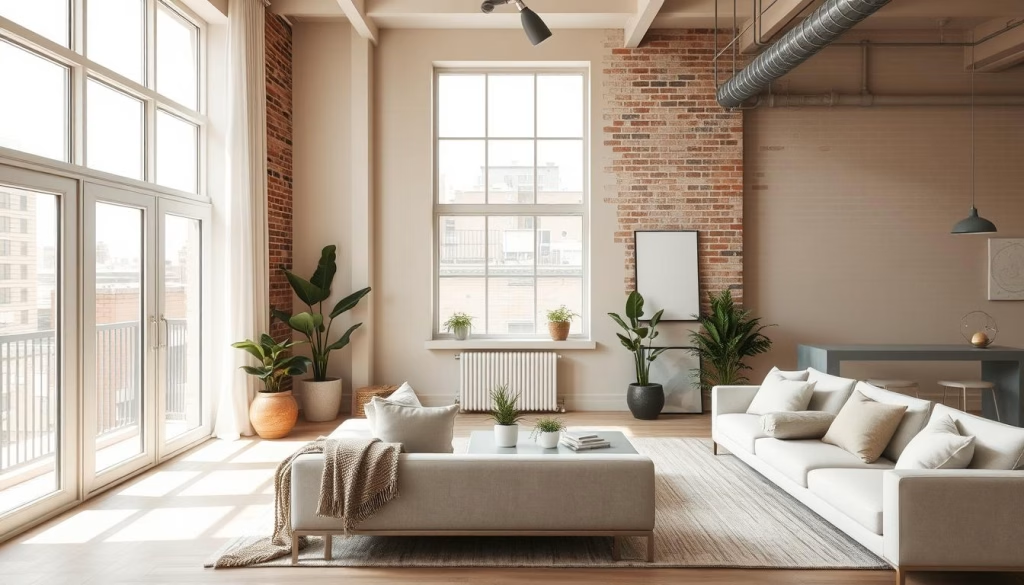
Choosing the Right Shades
Choosing the right shades is crucial for a neutral color palette. It should create a calm yet elegant atmosphere. Here are some common choices:
- Light Grays: They make spaces feel larger, working well with exposed beams and ductwork.
- Charcoal and Black: These add depth and drama, fitting well with metal and concrete.
- Soft Whites: They balance darker tones, keeping the space light and open.
Using these shades together keeps the space industrial yet warm and inviting.
Incorporating Earthy Tones
To soften the industrial look, add earthy tones. These can be rich browns or muted greens. They can be used in accessories, furniture, or accent walls. These tones blend well with metal and concrete, enhancing the look without clashing:
- Terracotta or Rust: Brings a rustic, organic feel that warms the space.
- Olive or Sage Green: Adds a natural element, creating a calm and balanced environment.
- Beige or Taupe: Provides a soft contrast to harsh materials, making the space cozy.
Using earthy tones wisely keeps the industrial design minimalist and functional. It also makes urban living spaces more welcoming.
Incorporating Reclaimed Wood Accents
Reclaimed wood accents add a unique character and history to modern industrial designs. They bring warmth and texture, balancing the cool tones of metal and concrete. This makes industrial spaces feel more inviting.
Benefits of Using Reclaimed Wood
Using reclaimed wood in industrial interiors is great for the environment. It reduces waste and saves trees. It also adds unique textures and stories to any room.
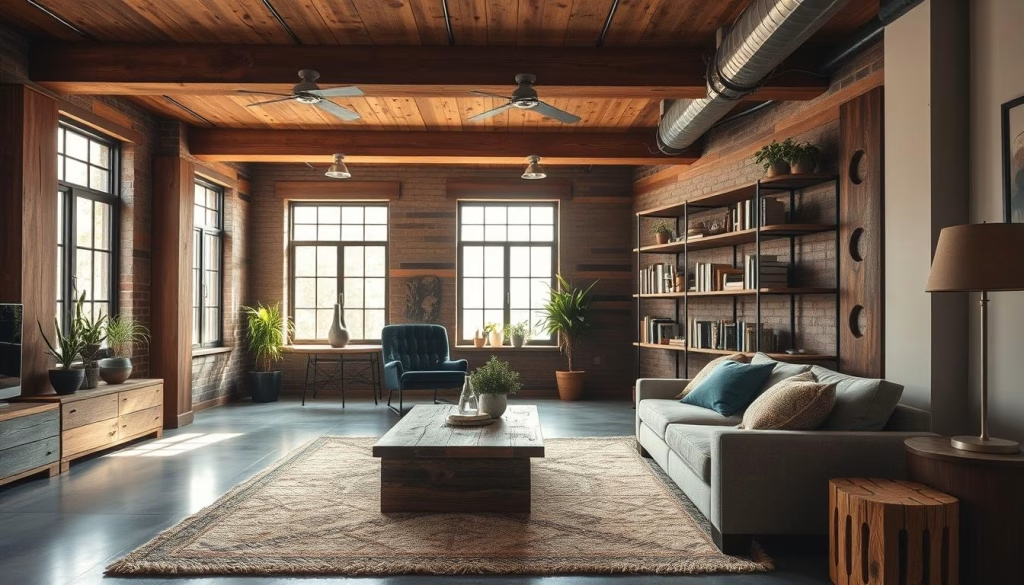
Creative Ways to Use Reclaimed Wood
There are many ways to use reclaimed wood in modern industrial designs. It can be used for:
- Structural beams: Enhancing the look and feel of the space.
- Furniture: Rustic tables, chairs, and shelves that stand out against metal.
- Wall art: Unique pieces that add flair and focus to the room.
- Flooring: Durable and striking, it can greatly improve the space.
- Decorative elements: Like picture frames, planters, or feature walls.
In conclusion, adding reclaimed wood accents to industrial designs is a smart choice. It highlights sustainable design and adds warmth and history. Reclaimed wood is a valuable asset for any modern industrial look.
Integrating Steel and Concrete Elements
Steel and concrete are key in modern industrial design. They mix function with beauty. These materials add strength and a rugged look to spaces. They can be used in both structure and decoration to bring an authentic industrial feel.
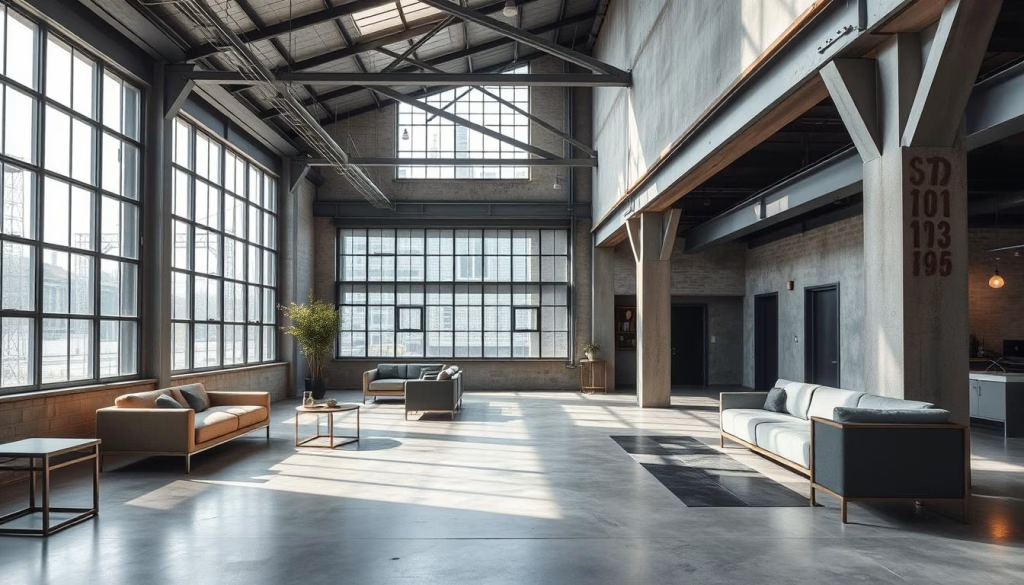
Structural vs. Decorative Uses
Steel and concrete are great for building strength in designs. Exposed beams and walls add a raw texture. They also serve as decorative pieces.
- Steel beams can be used to highlight the industrial look in open spaces.
- Concrete makes for sleek countertops and floors, adding a rustic feel.
- Industrial furniture often uses these materials, blending function with bold design.
Exposed materials like steel and concrete are essential in industrial design. They offer both practicality and style.
Maintaining and Caring for Steel and Concrete
Even though steel and concrete are durable, they need care to look and function well. Regular cleaning and proper maintenance can make them last longer:
- Sealing Concrete: Seal concrete often to stop stains and wear. It keeps the surface looking sleek and raw.
- Protecting Steel: Use anti-corrosion coatings on steel to prevent rust and damage, especially in damp places.
- Minimalistic Finishing: Choose clear or matte finishes to highlight the natural beauty of steel and concrete without hiding their texture.
By focusing on maintaining industrial materials, you keep your space looking industrial and functional. These steps help you use and care for steel and concrete effectively.
Maximizing Natural Light with Large Windows
Natural light is key in industrial chic decor, especially in cities where we often miss nature. Frank Lloyd Wright said adding natural elements to design boosts our well-being. Adding lots of large windows makes your space feel welcoming and healthy.
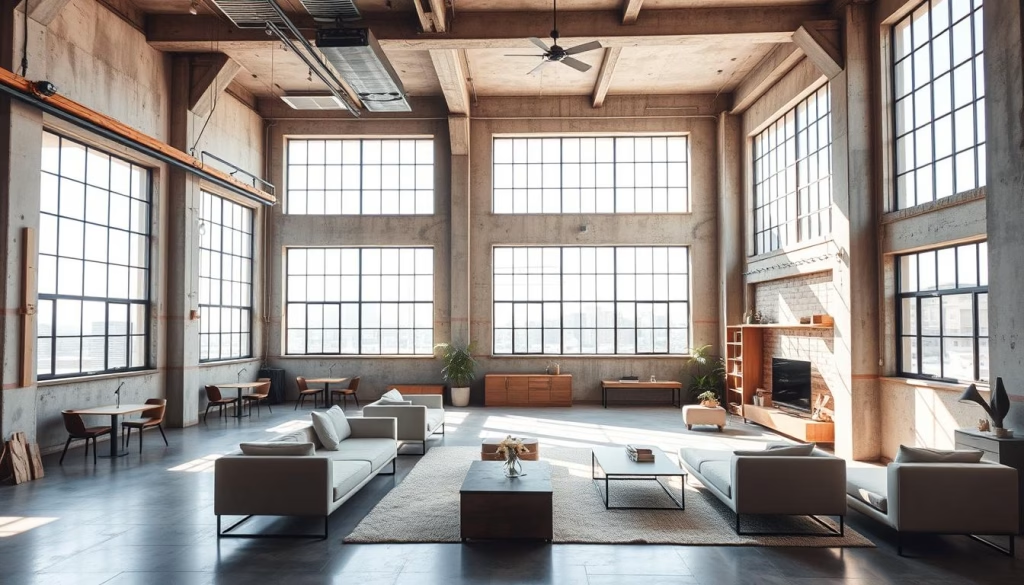
Types of Windows in Industrial Design
Industrial design often uses steel-framed or paneled factory windows. These keep the look and let in lots of light. Other types include:
- Glazed Walls: These let light fill rooms, making them bright and airy.
- Internal Windows: They help light move between rooms, making everything brighter.
- Roof Lights and Sun Tunnels: Great for areas with little outdoor light.
- Sliding Door Systems: Modern and slim, they let in lots of light.
- Tilt and Turn Windows: They let in a lot of light, even though they’re a bit bigger.
Window Treatments to Consider
Big windows are great for letting in light, but you also need window treatments. They help with privacy and controlling light. Here are some stylish and useful options:
| Type | Advantages | Best Suitable For |
|---|---|---|
| Roller Blinds | Simple and functional, easy to use | Living rooms, bedrooms |
| Sheer Curtains | Let in light while keeping things private | Dining areas, common rooms |
| Soft, Flowy Drapes | Soften light and cut down glare | Study rooms, reading nooks |
| Solar Control Glass | Keeps heat out, uses modern tech | Sunrooms, conservatories |
Using mirrors can also make a room brighter. By picking the right windows and treatments, you can make a bright, unified space that shows off industrial chic decor.
Open Floor Plans and High Ceilings
Open floor plans and high ceilings are key in modern industrial design. They make spaces feel bigger and more open. These features also let in more natural light and make moving around easier.
| Feature | Description |
|---|---|
| Open Floor Plans | Maximize views and allow for easy movement between living areas. |
| High Ceilings | Create an airy atmosphere and amplify the sense of space. |
| Double-Height Windows | Frame picturesque views and bring in abundant natural light. |
Loft style interiors often include special features like a Writer’s Cabin. It’s 500 square feet and has glass walls for a guest area. This adds to the open feel. Floor-to-ceiling windows also help, making the space feel connected to nature.
In one home, the living room has double-height windows. These windows show off a beautiful bay view. They blend the indoors with the outdoors perfectly.
The master bedroom shows off a mix of old and new. It has a custom leather and steel bed and a unique fireplace. The dining room has Iron and leather chairs around a Nolan Dining Table. It shows off the industrial chic style, combining comfort with design.
Industrial design is very popular in the US. It’s loved for its durability, historical feel, and flexibility. Open floor plans and high ceilings are key to its lasting appeal and versatility.
Exposed Brick Walls: A Defining Feature
Exposed brick walls are a key part of modern industrial design. They add texture and history to any room. These walls are now a big part of trendy kitchens, fitting well with many styles.
Creating an Exposed Brick Look
If you don’t have real brick walls, you can still get the look. You can use brick veneer or wallpaper to mimic exposed brick. Pick materials that look like real bricks, in colors like gray, brown, or red. Painting them different colors can also change the look.
Maintenance Tips for Brick Walls
Keeping exposed brick walls looking good is easy. Here are some tips to keep them looking great:
- t
- Sealing: Sealing the walls stops moisture from getting in and damaging them. It keeps them looking good for a long time. t
- Cleaning: Clean the walls gently to avoid harming the bricks. Use soft brushes and mild cleaners to remove dirt and stains.
Adding storage cabinets against brick walls can make your kitchen look modern. Vintage brick walls with rustic items can make a space feel cozy. Look at Casa Forasté in Guadalajara, Mexico, for inspiration. It has big exposed brick walls, steel beams, and large windows.
In short, exposed brick walls are not just a design feature. They are also durable and easy to care for. This makes them a great choice for modern and industrial homes.
Lighting Essentials for Industrial Chic Decor
Lighting is key in industrial chic decor, adding both function and beauty. The industrial style has grown ten times more popular in recent years. It focuses on simple yet striking lights. Companies like Industville make industrial lighting that looks raw and unfinished, perfect for modern homes.
Industrial chic decor often uses metal fixtures in different colors and textures. You’ll see Edison bulbs and sleek metal pendants, showing the era’s rugged beauty. Homeowners like to mix metallic shades and bright colors for a unique look. Vintage-inspired industrial lighting adds character and works well in both modern and rustic spaces.
In areas like the kitchen, task lighting is crucial. Industrial pendant lighting is both useful and stylish in small spaces. Table lamps and tripod lamps are popular for adding to industrial looks without losing style. Wall sconces are great for bedrooms because they’re sleek and useful.
Warm industrial lighting, like chandeliers, goes well with beige tones and wooden floors. You can choose from shapes like cones and spheres to versatile chandeliers. The right lighting can make your industrial chic decor stand out. Here’s a table comparing different industrial lighting options for various rooms.
| Lighting Type | Best Use | Key Features |
|---|---|---|
| Pendant Lighting | Kitchen & Dining Room | Practical, Stylish, Space-Saving |
| Tripod Lamps | Living Room | Versatile, Modern Appeal |
| Wall Sconces | Bedroom | Sleek Design, Functional |
| Chandeliers | Living Room, Dining Room | Warm Lighting, Versatile |
Choosing the Right Furniture for Loft Style Interiors
In recent years, loft style interiors have become very popular. They mix modern and vintage elements for a unique look. This style looks best in spaces with lots of sunlight and old details like exposed brick and wood beams.
Key Pieces to Include
Choosing the right furniture is key for loft style interiors. Look for overstuffed leather armchairs, Chesterfield sofas, and Tolix-style bar stools. These pieces are both practical and stylish.
For open-plan living, oversized Chesterfield leather sofas and modular sofas are great. They come in linen, leather, or cotton. Also, upholstered ottomans are popular for adding comfort.
In bedrooms, low loft-style beds work well, especially in low-ceiling mezzanine spaces. Adding under-bed storage, wall-mounted shelving, and mobile dressers keeps the space tidy.
Mixing Modern and Rustic Elements
A good loft style interior balances modern and rustic elements. This mix adds warmth and texture to the space. Reclaimed wood furniture and decor bring character and authenticity.
Metal bar stools, large stainless-steel kitchen benches, and recycled wooden islands make kitchens stylish and efficient. Quirky details like old laundry carts or wagon wheels add an industrial touch. High-quality furniture ensures each piece stands out, making your space more meaningful.
Decking Out Your Space with Minimalist Accessories
Minimalist accessories are key in modern industrial design. They help highlight your space without cluttering it. By picking the right pieces, you can make a space that’s both functional and simple.
Choosing Statement Pieces
Focus on statement pieces when using minimalist accessories. Look for oversized artwork or metal sculptures to grab attention. These items should match the industrial feel of your space, like steel and concrete.
Choosing wisely, you can boost the industrial look while keeping things simple.
The Role of Art and Mirrors
Art and mirrors are crucial in modern industrial design. Choose artwork that shows the raw, industrial spirit. Geometric shapes and clean lines work well.
Mirrors are great for adding light and making rooms feel bigger. Place them to brighten and add depth to your space.
With these accessories, you can make a space that’s both modern and timeless.
FAQ
What are the key characteristics of modern industrial interior design?
Modern industrial design features exposed steel beams and concrete floors. It also has large windows and high ceilings. The look combines old and new, using materials like metal and wood in simple colors.
How can I integrate reclaimed wood accents into my industrial space?
Use reclaimed wood for beams, wall art, or furniture. It brings warmth and history to spaces with steel and concrete.
What type of windows is best for modern industrial interiors?
Steel-framed or paneled factory windows are perfect. They let in lots of natural light and keep the industrial feel. Big windows make spaces feel bigger and more welcoming.
How do I maintain and care for steel and concrete elements in my home?
Keep them looking raw by sealing and finishing them lightly. Clean and seal them regularly to protect them from damage.
What colors should I use in a modern industrial interior design?
Stick to a neutral palette with black, gray, and white. Adding earthy tones can warm the space while keeping it minimalist.
How can I create the look of exposed brick walls if my space doesn’t have them?
Use veneer or wallpaper to mimic exposed brick. These methods add texture and history to your space.
What lighting options work best for industrial chic decor?
Choose lighting that shows off the raw look of interiors. Use Edison bulbs or metal pendants to reflect the industrial era.
How do open floor plans and high ceilings contribute to industrial design?
They make spaces feel open and airy. This design promotes freedom and flexibility, making areas flow well together.
What are the benefits of using minimalist accessories in an industrial space?
Minimalist accessories highlight the industrial look without cluttering it. Big art or metal items create focus. Mirrors also make spaces feel larger.
What furniture pieces are essential for loft-style interiors?
Key pieces include leather sofas, metal chairs, and simple wood tables. Mixing modern and rustic elements softens the industrial look. This creates a cozy and inviting space.
Source Links
- 14 Best Modern Industrial Interior Design Style Ideas – Foyr
- Things You Need to Know About Industrial Interior Design
- Industrial Interior Design: Everything You Need to Know
- What Is Industrial Interior Design?
- Industrial Interior Design vs. Neo-Industrial Interior Design – Climadoor
- Industrial Interior Design Style Guide | AR Interiors — AR Interiors
- Industrial Interior Design: Everything You Need to Know About This Raw and Commanding Style


